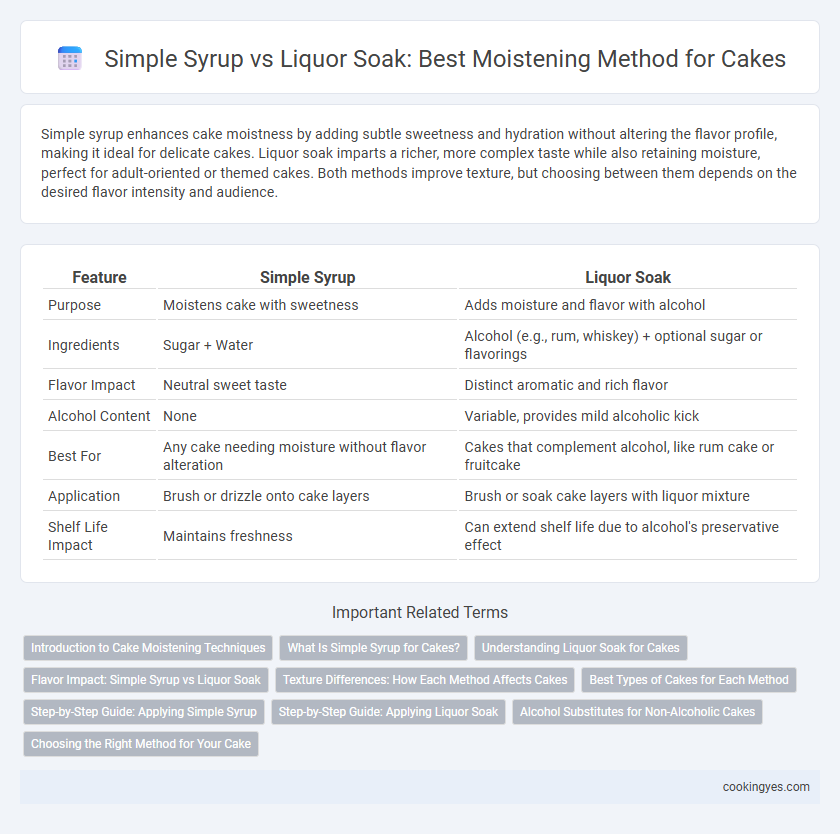Simple syrup enhances cake moistness by adding subtle sweetness and hydration without altering the flavor profile, making it ideal for delicate cakes. Liquor soak imparts a richer, more complex taste while also retaining moisture, perfect for adult-oriented or themed cakes. Both methods improve texture, but choosing between them depends on the desired flavor intensity and audience.
Table of Comparison
| Feature | Simple Syrup | Liquor Soak |
|---|---|---|
| Purpose | Moistens cake with sweetness | Adds moisture and flavor with alcohol |
| Ingredients | Sugar + Water | Alcohol (e.g., rum, whiskey) + optional sugar or flavorings |
| Flavor Impact | Neutral sweet taste | Distinct aromatic and rich flavor |
| Alcohol Content | None | Variable, provides mild alcoholic kick |
| Best For | Any cake needing moisture without flavor alteration | Cakes that complement alcohol, like rum cake or fruitcake |
| Application | Brush or drizzle onto cake layers | Brush or soak cake layers with liquor mixture |
| Shelf Life Impact | Maintains freshness | Can extend shelf life due to alcohol's preservative effect |
Introduction to Cake Moistening Techniques
Simple syrup and liquor soak serve as essential cake moistening techniques that enhance texture and flavor. Simple syrup, a mixture of sugar and water, penetrates cake layers evenly, adding moisture without altering taste significantly. Liquor soak introduces a complex flavor profile while moistening, ideal for dense cakes or those that benefit from a boozy undertone.
What Is Simple Syrup for Cakes?
Simple syrup for cakes is a mixture of sugar and water heated until dissolved, creating a liquid sweetener that easily soaks into cake layers to enhance moisture and tenderness. It is commonly flavored with vanilla, lemon, or other extracts to complement the cake's flavor profile without altering its texture. Unlike liquor soaks, simple syrup adds sweetness without alcohol content, making it suitable for all ages and preserving the cake's delicate crumb structure.
Understanding Liquor Soak for Cakes
Liquor soak for cakes enhances moisture by infusing alcohol combined with sugar or juice, creating a rich, flavorful depth that simple syrup alone cannot achieve. This method penetrates cake layers more thoroughly, imparting a distinct aroma and complexity ideal for spiced or fruit cakes. Proper application of liquor soak maintains cake texture while delivering an elevated taste profile cherished in traditional and gourmet baking.
Flavor Impact: Simple Syrup vs Liquor Soak
Simple syrup enhances cake moisture with a subtle sweetness that complements a wide range of flavors without overpowering the recipe. Liquor soak introduces complex aromatic notes and a depth of flavor, imparting distinctive character depending on the type of liquor used, such as rum or brandy. The choice between simple syrup and liquor soak significantly influences the cake's final taste profile, balancing moisture with intensity and richness.
Texture Differences: How Each Method Affects Cakes
Simple syrup enhances cake moisture by penetrating evenly, resulting in a tender, consistent crumb and soft texture without altering the cake's flavor profile. Liquor soak adds moisture along with flavor complexity, creating a denser texture with subtle chewiness, influenced by alcohol content and soaking duration. Choosing between simple syrup and liquor soak depends on desired texture outcomes and flavor enhancement, with syrup yielding light moistness and liquor contributing to a richer, slightly firmer bite.
Best Types of Cakes for Each Method
Simple syrup is ideal for sponge cakes, chiffon cakes, and angel food cakes due to its ability to evenly penetrate the crumb without altering the flavor profile. Liquor soak works best with fruitcakes, rum cakes, and traditional holiday cakes, enhancing richness and complexity through alcohol-infused moisture. Choosing between these methods depends on the cake's texture and desired flavor intensity, where simple syrup provides subtle hydration and liquor soak delivers bold taste enhancement.
Step-by-Step Guide: Applying Simple Syrup
Applying simple syrup to cake layers involves brushing a sugar-water mixture evenly over the surface to add moisture and enhance sweetness without altering the flavor profile. Start by heating equal parts water and granulated sugar until the sugar dissolves completely, then allow the syrup to cool before use. Use a pastry brush to gently coat each layer, ensuring thorough absorption for a consistently moist cake base.
Step-by-Step Guide: Applying Liquor Soak
To apply a liquor soak for cake moistening, start by selecting a spirit such as rum, whiskey, or brandy that complements the cake flavor. Use a pastry brush or skewer to evenly puncture the cake layers, allowing the liquor to penetrate deeply and enhance moisture and taste. Let the cake rest for at least 30 minutes after soaking to fully absorb the liquor, resulting in a rich and moist texture without overpowering sweetness.
Alcohol Substitutes for Non-Alcoholic Cakes
Simple syrup is an effective alternative to liquor soak for moistening cakes, especially in non-alcoholic recipes, providing sweetness and moisture without altering the flavor profile. Alcohol substitutes such as fruit juices, flavored syrups, or herbal infusions can enhance the cake's moisture while maintaining a rich taste experience suitable for all ages. These non-alcoholic options prevent drying while preserving texture and adding depth, ensuring cakes remain soft and flavorful.
Choosing the Right Method for Your Cake
Simple syrup provides a subtle sweetness and consistent moisture, making it ideal for delicate cakes that require gentle flavor enhancement without overpowering the original taste. Liquor soak imparts a rich, complex flavor and adds moisture, perfect for dense or boozy cakes that benefit from an adult twist. Selecting the right method depends on the cake's texture and desired flavor profile, with simple syrup suited for light cakes and liquor soak enhancing richer, more robust recipes.
Simple syrup vs Liquor soak for cake moistening Infographic

 cookingyes.com
cookingyes.com